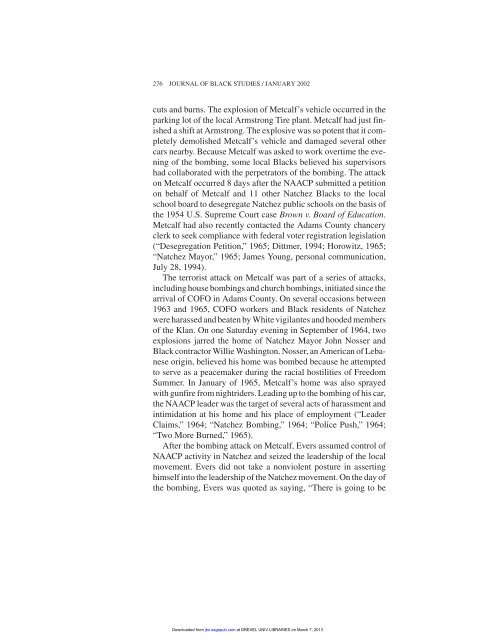MXGM Self-Defence Manual
MXGM Self-Defence Manual
MXGM Self-Defence Manual
You also want an ePaper? Increase the reach of your titles
YUMPU automatically turns print PDFs into web optimized ePapers that Google loves.
276 JOURNAL OF BLACK STUDIES / JANUARY 2002<br />
cuts and burns. The explosion of Metcalf’s vehicle occurred in the<br />
parking lot of the local Armstrong Tire plant. Metcalf had just finished<br />
a shift at Armstrong. The explosive was so potent that it completely<br />
demolished Metcalf’s vehicle and damaged several other<br />
cars nearby. Because Metcalf was asked to work overtime the evening<br />
of the bombing, some local Blacks believed his supervisors<br />
had collaborated with the perpetrators of the bombing. The attack<br />
on Metcalf occurred 8 days after the NAACP submitted a petition<br />
on behalf of Metcalf and 11 other Natchez Blacks to the local<br />
school board to desegregate Natchez public schools on the basis of<br />
the 1954 U.S. Supreme Court case Brown v. Board of Education.<br />
Metcalf had also recently contacted the Adams County chancery<br />
clerk to seek compliance with federal voter registration legislation<br />
(“Desegregation Petition,” 1965; Dittmer, 1994; Horowitz, 1965;<br />
“Natchez Mayor,” 1965; James Young, personal communication,<br />
July 28, 1994).<br />
The terrorist attack on Metcalf was part of a series of attacks,<br />
including house bombings and church bombings, initiated since the<br />
arrival of COFO in Adams County. On several occasions between<br />
1963 and 1965, COFO workers and Black residents of Natchez<br />
were harassed and beaten by White vigilantes and hooded members<br />
of the Klan. On one Saturday evening in September of 1964, two<br />
explosions jarred the home of Natchez Mayor John Nosser and<br />
Black contractor Willie Washington. Nosser, an American of Lebanese<br />
origin, believed his home was bombed because he attempted<br />
to serve as a peacemaker during the racial hostilities of Freedom<br />
Summer. In January of 1965, Metcalf’s home was also sprayed<br />
with gunfire from nightriders. Leading up to the bombing of his car,<br />
the NAACP leader was the target of several acts of harassment and<br />
intimidation at his home and his place of employment (“Leader<br />
Claims,” 1964; “Natchez Bombing,” 1964; “Police Push,” 1964;<br />
“Two More Burned,” 1965).<br />
After the bombing attack on Metcalf, Evers assumed control of<br />
NAACP activity in Natchez and seized the leadership of the local<br />
movement. Evers did not take a nonviolent posture in asserting<br />
himself into the leadership of the Natchez movement. On the day of<br />
the bombing, Evers was quoted as saying, “There is going to be<br />
Downloaded from jbs.sagepub.com at DREXEL UNIV LIBRARIES on March 7, 2013


